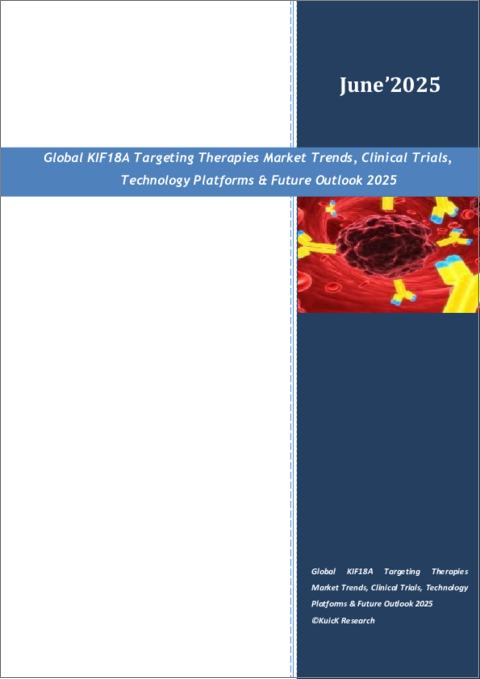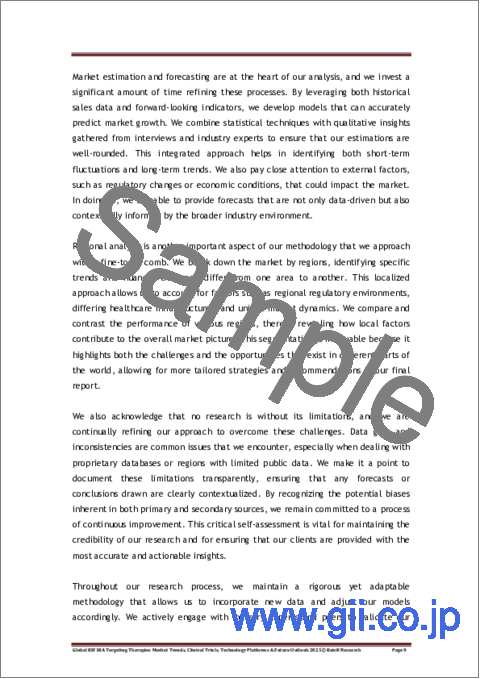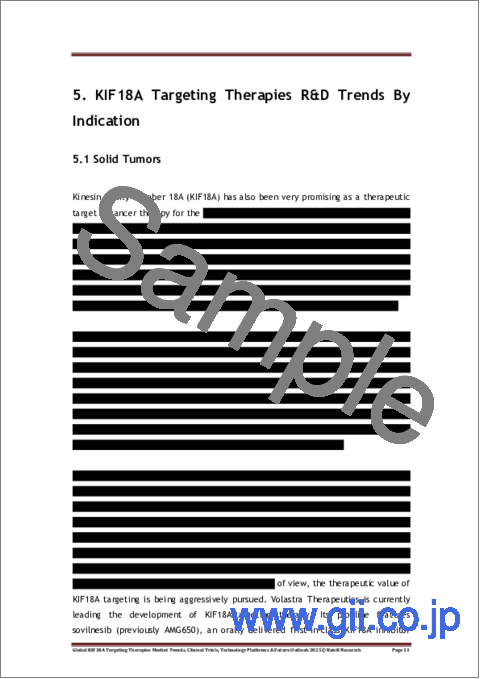|
|
市場調査レポート
商品コード
1756385
KIF18A標的治療薬の世界市場:市場動向、臨床試験、技術プラットフォーム、将来の見通し(2025年)Global KIF18A Targeting Therapies Market Trends, Clinical Trials, Technology Platforms & Future Outlook 2025 |
||||||
|
|||||||
| KIF18A標的治療薬の世界市場:市場動向、臨床試験、技術プラットフォーム、将来の見通し(2025年) |
|
出版日: 2025年06月01日
発行: KuicK Research
ページ情報: 英文 75 Pages
納期: 即日から翌営業日
|
全表示
- 概要
- 図表
- 目次
KIF18A標的治療薬の世界市場:市場動向、臨床試験、技術プラットフォーム、将来の見通し(2025年)レポートのハイライトと調査結果:
- 2030年までに最初のKIF18A標的治療薬の商業利用が可能になる見込み
- 最も高い開発段階:第I/II相
- 臨床試験中のKIF18A標的治療薬:>10以上の治療薬
- KIF18A標的療法の臨床試験インサイト:企業別、国別、適応症別、相別
- KIF18A標的治療薬市場開拓動向の洞察
- KIF18A治療薬技術プラットフォームの洞察
KIF18A治療薬の必要性と当レポートの意義
キネシンファミリーのモータータンパク質であるKIF18Aは、有糸分裂時の染色体整列制御に必須です。KIF18Aは、キネトコア微小管のプラス端に移動し、その伸長を抑制することにより、細胞分裂前のメタフェース板において染色体の整列を確実にします。このプロセスは、染色体の正しい分離とゲノムの安定性に不可欠です。KIF18Aが欠失または非機能性の場合、細胞は通常、染色体の位置がずれたり、分裂が遅れたり、染色体数が異常に増えたりして、がんの一般的な特徴であるゲノムの不安定性を引き起こします。KIF18Aは乳がん、卵巣がん、大腸がん、膵臓がんなど多くのがんで過剰発現しており、その高発現は予後不良、転移、化学療法抵抗性と関連しています。したがって、KIF18Aは新しいがん治療の有望な標的として認識されています。
KIF18Aの治療的価値は、細胞分裂におけるその中心的機能にあります。KIF18Aを標的とし、そのモーター機能を阻害することで、有糸分裂を妨害し、がん細胞を優先的に死滅させ、正常細胞はそのまま残すことができます。正確な有糸分裂に依存するがん細胞を標的にする可能性は、すべての分裂細胞を無差別に標的にする従来の化学療法よりも的を絞ったアプローチです。KIF18Aの活性を阻害するために、さまざまなアプローチが検討されています。最も直接的な戦略は、KIF18Aのモーター活性を阻害する低分子阻害剤を作り、有糸分裂中の微小管ダイナミクスを制御できなくすることです。キネトコアにおけるKIF18Aの機能を阻害することによって、これらの阻害剤は有糸分裂の失敗を引き起こし、その結果がん細胞が死滅します。
モータードメインの阻害に加え、もう一つのアプローチはKIF18Aの機能を支配する制御経路を阻害することです。リン酸化やアダプタータンパク質との結合のような翻訳後の修飾は、KIF18Aの局在と活性を調節します。このような制御経路に干渉することで、KIF18Aの活性を操作する戦略が得られ、直接モーターを阻害するよりも毒性が軽減される可能性があります。KIF18Aをリン酸化するキナーゼを阻害したり、制御タンパク質との相互作用を阻害することは、より特異的な治療戦略である可能性があります。
当レポートは、KIF18Aの臨床的および分子学的特徴を包括的に分析し、その生物学的機能、発がん性役割、治療の可能性に焦点を当てて開発されました。潜在的な創薬標的としてKIF18Aへの関心が高まっていることを認識し、研究者から医薬品開発者までの利害関係者が標的タンパク質を把握しやすくなるよう、研究に基づいた詳細な情報を提供する形で内容を最適化しました。KIF18Aに関する広範な理解は、この重要ながんタンパク質に対するがん治療法をデザインするための重要な基盤であると確信しています。
報告書に含まれる臨床試験の洞察
KIF18Aに対するような新しい治療戦略の安全性と有効性を評価するためには、臨床試験が必要です。これに伴い、当レポートでは世界的に開発されているKIF18Aを標的とした治療法の概要を掲載しています。各治療法の臨床適応症、開発段階、治験スポンサー、地理的位置について詳述しています。これらの臨床試験は、重要な臨床データを生み出し、認知度を高め、投資家を引き寄せることで、KIF18A標的療法の将来の市場機会の方向性に大きな影響を与えるものと考えられます。
KIF18A治療薬の研究開発に関与する主要企業
現在、複数のバイオテクノロジー企業がKIF18Aに対する治療開発の最前線にあり、複数の化合物が異なる医薬品開発段階にあります。この分野で圧倒的な力を持つVolastra Therapeuticsは、KIF18Aを標的とする幅広い薬剤を開発しています。その最も著名な候補のひとつがソビルネシブ(AMG650)です。ソビルネシブはもともとAmgenによって開発された低分子阻害剤で、現在、治療に難渋するプラチナ製剤抵抗性の高悪性度漿液性卵巣がん(HGSOC)患者を対象とした第I相臨床試験中です。Volastraはまた、自社開発の新規経口KIF18A阻害剤であるVLS-1488を開発中であり、現在第I/II相臨床試験中です。これらの臨床試験の初期データから、良好な安全性プロファイルと、特に染色体不安定性の高い腫瘍に対する抗腫瘍効果の初期エビデンスが明らかになり、KIF18A阻害の治療可能性がさらに検証されました。
KIF18A標的治療市場のもう一つの参入企業であるAccent Therapeuticsは、経口薬候補であるATX-295を開発中であり、同じく染色体不安定性を有する固形がんを対象とした第I/II相試験中です。ATX-295は、特に高悪性度の漿液性卵巣がんやトリプルネガティブ乳がんのモデルにおいて、前臨床試験で高い抗腫瘍効果を示しています。Accentのアプローチは、全ゲノム倍加のようなコンパニオンバイオマーカーを活用して、患者選択に情報を提供し、KIF18A阻害の治療指標を高めることです。
KIF18A阻害剤の開発には、人工知能(AI)を活用した創薬プラットフォームなどの開発技術が急速に利用されつつあります。中でもInsilico Medicine社は、KIF18Aの新規阻害剤を発見し最適化するためにAI駆動型プラットフォームを活用しています。インシリコのChemistry42とPandaOmicsプラットフォームは、前臨床試験において高い特異性と魅力的な抗腫瘍活性を有する大環状KIF18A阻害剤ISM9682の発見を促進しました。このようなAIを活用した手法は、有望な治療薬をより迅速かつ正確に同定することを可能にし、医薬品開発に革命をもたらしています。
KIF18A治療薬セグメントの将来の方向性を強調するレポート
複数のKIF18A標的治療薬が臨床試験を進行中であり、この領域は非常に有望です。多くの企業における初期段階のデータから、KIF18A阻害剤は染色体不安定性のあるがん細胞を選択的に死滅させることができ、精密腫瘍学に適していることが示唆されています。強力な初期データは、AIに基づく創薬の進歩や規制当局の後ろ盾と相まって、KIF18A標的治療薬が、従来の治療法に抵抗性を示すがんの治療において貴重な武器になる可能性を示しています。これらの治療法の有効性は、ゲノムの不安定性を有する患者に対する、さらにターゲットを絞った効率的な治療法への道を開くものと期待されます。
今後、KIF18A標的治療の領域は、研究開発費の増加、様々ながん種への応用の拡大、標的治療に対する需要の高まりにより、かなりの成長が見込まれます。バイオテクノロジー企業による大手製薬企業との戦略的提携は、商業化のスケジュールを早めるのに役立つと予想されます。より多くの臨床データが出るにつれて、市場の取り込みも強化され、KIF18A阻害剤が新たな高精度がん治療薬クラスとして確立される可能性も期待されます。
目次
第1章 調査手法
第2章 KIF18A標的療法のイントロダクション
- キネシンファミリーとKIF18Aの概要
- 歴史と開発
第3章 科学的・生物学的背景
- KIF18Aの概要
- 発がん性の役割と治療の根拠
第4章 KIF18Aを標的とした治療法
- 低分子阻害剤
- RNAiベースの戦略
第5章 KIF18A標的療法の適応症別研究開発動向
- 固形腫瘍
- 造血悪性腫瘍
第6章 KIF18A標的療法:薬剤クラス別の併用戦略
第7章 KIF18A標的療法市場の潜在的概要
- 現在のシナリオ
- 将来の研究開発と商業機会
第8章 KIF18A標的治療開発技術プラットフォーム
第9章 KIF18A標的療法の臨床試験の概要
- 企業別
- 国別
- 適応症別
- 相別
- 優先ステータス別
第10章 KIF18A標的療法の臨床試験:企業、適応症、相別
- 研究
- 前臨床
- 第I相
- 第I/II相
第11章 KIF18A標的治療市場力学
- 促進要因と機会
- 課題と抑制要因
第12章 競合情勢
- Accent Therapeutics
- Amgen
- Apeiron Therapeutics
- Aurigene Oncology
- Genhouse Bio
- GeneScience Pharmaceuticals
- Iambic Therapeutics
- Innogate Pharma
- Insilico Medicine
- Satya Pharma
- Tailor Bio
- Volastra
List of Figures
- Figure 2-1: Kinesin Family Overview
- Figure 2-2: KIF18A - Overview
- Figure 2-3: Discovery and Evolution of KIF18A Research
- Figure 3-1: KIF18A - Role In Mitosis
- Figure 3-2: KIF18A - Expression in Normal & Cancer Tissues
- Figure 3-3: KIF18A as Therapeutic Target in Cancer
- Figure 3-4: KIF18A - Synthetic Lethality Pathway
- Figure 3-5: KIF18A as Prognostic Marker in Cancer
- Figure 4-1: Small Molecule KIF18A Inhibitors - Mechanism of Action
- Figure 4-2: RNAi-Mediated Silencing of KIF18A - Mechanism of Action
- Figure 4-3: KIF18A RNAi - Effects on Tumor Cell Phenotypes
- Figure 5-1: SOVI-2302 Phase 1 (NCT06084416) Study - Initiation & Completion Year
- Figure 5-2: VLS-1488-2201 Phase 1/2 (NCT05902988) Study - Initiation & Completion Year
- Figure 5-3: ATX-295-001 Phase 1/2 (NCT06799065) Study - Initiation & Completion Year
- Figure 5-4: GH2616-101 Phase 1 (NCT06329206) Study - Initiation & Completion Year
- Figure 5-5: KIF18A In Hematological Malignancies - Role & Therapeutic Opportunity
- Figure 7-1: KIF18A Targeting Therapies - Future Opportunities
- Figure 8-1: Chemistry42 - Insilico Medicine
- Figure 8-2: CINtech Platform - Volastra Therapeutics
- Figure 8-3: Unnamed Platform - Accent Therapeutics
- Figure 8-4: Unnamed Platform - Tailor Bio
- Figure 9-1: Global - KF18A Targeting Therapies Clinical Trials By Company, 2025
- Figure 9-2: Global - KF18A Targeting Therapies Clinical Trials By Country, 2025
- Figure 9-3: Global - KF18A Targeting Therapies Clinical Trials By Indication, 2025
- Figure 9-4: Global - KF18A Targeting Therapies Clinical Trials By Phase, 2025
- Figure 9-5: Global - KF18A Targeting Therapies Clinical Trials By Priority Status, 2025
- Figure 11-1: KIF18A Targeting Therapies Market - Drivers & Opportunities
- Figure 11-2: KIF18A Targeting Therapies Market - Challenges & Restraints
List of Tables
- Table 6-1: KIF18A Targeting Therapy In Combination With Chemotherapy
- Table 6-2: KIF18A Targeting Therapy In Combination With Immunotherapy
- Table 6-3: KIF18A Targeting Therapy In Combination With Targeted Therapy
Global KIF18A Targeting Therapies Market Trends, Clinical Trials, Technology Platforms & Future Outlook 2025 Report Highlights & Findings:
- First KIF18A Targeting Therapy Commercial Availability Expected By 2030
- Highest Phase Of Development: Phase-I/II
- KIF18A Targeting Therapies In Clinical Trials: > 10 Therapies
- KIF18A Targeting Therapies Clinical Trials Insight By Company, Country, Indication & Phase
- KIF18A Targeting Therapies Market Development Trends Insight
- KIF18A Therapies Technology Platforms Insight
Need For KIF18A Therapies & Why This Report?
KIF18A, a kinesin family motor protein, is essential for chromosome alignment regulation during mitosis. It acts by moving to the plus ends of kinetochore microtubules and suppressing their elongation, thus ensuring chromosomes are well aligned at the metaphase plate prior to cell division. This process is essential for correct chromosome segregation and genomic stability. When KIF18A is absent or nonfunctional, cells usually have misaligned chromosomes, delayed mitosis, or abnormal chromosome numbers, causing genomic instability, a common feature of cancer. KIF18A is overexpressed in many cancers, such as breast cancer, ovarian cancer, colorectal cancer, and pancreatic cancer, and its high expression is associated with poor prognosis, more metastasis, and chemotherapy resistance. Therefore, KIF18A has been recognized as a promising target for new cancer treatments.
The therapeutic value of KIF18A lies in its central function in cell division. Targeting KIF18A and inhibiting its motor function can interfere with mitosis, killing cancer cells preferentially and leaving normal cells intact. The potential to target cancer cells' dependency on accurate mitosis is a more targeted approach than conventional chemotherapies, which indiscriminately target all dividing cells. There are various approaches being explored to block KIF18A activity. The most direct strategy is the generation of small molecule inhibitors that inhibit KIF18A's motor activity, such that it can no longer control microtubule dynamics during mitosis. By disrupting KIF18A's function at the kinetochore, these inhibitors cause mitotic failure, which results in cancer cell death.
Along with inhibition of the motor domain, another approach is to interfere with the regulatory pathways that govern KIF18A function. Post translational modifications like phosphorylation, and binding to adaptor proteins modulate the localization and activity of KIF18A. Interfering with these regulatory pathways provides a strategy to manipulate KIF18A activity with potentially reduced toxicity over direct motor inhibition. Inhibiting kinases that phosphorylate KIF18A or interfering with its interactions with regulatory proteins might represent a more specific therapeutic strategy.
This report has been developed to offer a comprehensive analysis of clinical and molecular features of KIF18A, focusing on its biological functions, oncogenic roles, and therapeutic potential. Recognizing the increasing interest in KIF18A as a potential drug target, the content has been optimized in a manner that it provides research based, in-depth information that will facilitate stakeholders, from researchers to pharma developers, to grasp the target protein. We believe that an extensive understanding of KIF18A is a critical foundation for designing cancer therapies against this key cancer protein.
Clinical Trials Insight Included In Report
Clinical trials are necessary for assessing the safety and efficacy of new therapeutic strategies, such as those against KIF18A. In line with this, this report comprises an overview of KIF18A targeting therapies being developed globally. It details each therapy's clinical indication, stage of development, trial sponsors, and geographic location. We believe these trials are poised to have a major impact on the direction of future market opportunity for KIF18Atargeting therapies by producing crucial clinical data, raising awareness, and drawing in investors.
Key Companies Involved In R&D Of KIF18A Therapies
Several biotech firms are now at the forefront of developing treatments against KIF18A, with multiple compounds in different stages of drug development. Volastra Therapeutics, a dominant force in this space, has built a wide range of KIF18A targeting drugs. One of its most prominent candidates is Sovilnesib (AMG650), a small molecule inhibitor that was originally developed by Amgen and is currently in Phase I clinical trials for patients with platinum resistant high grade serous ovarian cancer (HGSOC), an aggressive to treat population. Volastra is also developing VLS-1488, a novel oral KIF18A inhibitor developed in-house, now in Phase I/II clinical trials. Initial data from these trials have revealed favorable safety profiles and early evidence of anti tumor effects, especially for tumors with high chromosomal instability, further validating the therapeutic potential of inhibition of KIF18A.
Accent Therapeutics, another player in the KIF18A targeted therapy market, is developing ATX-295, an oral drug candidate, also in Phase I/II trials for solid tumors with chromosomal instability. ATX-295 has demonstrated high preclinical anti tumor efficacy, especially in models of high grade serous ovarian and triple negative breast cancer. Accent's approach is to utilize companion biomarkers, like whole genome doubling, to inform patient selection and enhance the therapeutic index of KIF18A inhibition.
Emerging technologies, including artificial intelligence (AI) facilitated drug discovery platforms, are rapidly being used to develop KIF18A inhibitors. Insilico Medicine, among other firms, utilizes AI driven platforms to discover and optimize novel inhibitors of KIF18A. Insilico's Chemistry42 and PandaOmics platforms facilitated the discovery of ISM9682, a macrocyclic KIF18A inhibitor with high specificity and attractive anti tumor activity in preclinical trials. These AI empowered methods are revolutionizing drug development by allowing faster and more precise identification of prospective therapeutics.
Report Highlighting Future Direction Of The KIF18A Therapies Segment
With multiple KIF18A targeted therapies progressing through clinical trials, the area is highly promising. Early stage data across a number of companies suggest that KIF18A inhibitors can selectively kill cancer cells with chromosomal instability and are thus well suited for precision oncology. The robust initial data, coupled with advances in AI based drug discovery and regulatory backing, indicate that KIF18A targeted therapies may become a valuable weapon in the treatment of those cancers that are refractory to conventional treatments. The efficacy of these therapies is anticipated to pave the way for even more targeted, efficient therapies for patients with genomic instability.
In the future, the KIF18A targeted therapy space is anticipated to see considerable growth due to rising R&D expenditure, growing applications in various cancer types, and heightened demand for targeted therapy. Biotech companies' strategic collaborations with major pharmaceutical companies are expected to help hasten commercialization timelines. As more clinical data emerge, market uptake is also expected to get bolstered and potentially establish KIF18A inhibitors as a new precision oncology class of drugs.
Table of Contents
1. Research Methodology
2. Introduction To KIF18A Targeting Therapies
- 2.1 Overview of Kinesin Family & KIF18A
- 2.2 History & Development
3. Scientific & Biological Background
- 3.1 Overview of KIF18A
- 3.2 Oncogenic Role & Therapeutic Rationale
4. Therapeutic Approaches Targeting KIF18A
- 4.1 Small Molecule Inhibitors
- 4.2 RNAi Based Strategies
5. KIF18A Targeting Therapies R&D Trends By Indication
- 5.1 Solid Tumors
- 5.2 Hematological Malignancies
6. KIF18A Targeting Therapies Combination Strategies By Drug Class
7. KIF18A Targeting Therapies Market Potential Overview
- 7.1 Current Scenario
- 7.2 Future R&D & Commercial Opportunities
8. KIF18A Targeting Therapies Development Technology Platforms
9. KIF18A Targeting Therapies Clinical Trials Overview
- 9.1 By Company
- 9.2 By Country
- 9.3 By Indication
- 9.4 By Phase
- 9.5 By Priority Status
10. KIF18A Targeting Therapies Clinical Trials Insight By Company, Indication & Phase
- 10.1 Research
- 10.2 Preclinical
- 10.3 Phase I
- 10.4 Phase I/II
11. KIF18A Targeting Therapies Market Dynamics
- 11.1 Drivers & Opportunities
- 11.2 Challenges & Restraints
12. Competitive Landscape
- 12.1 Accent Therapeutics
- 12.2 Amgen
- 12.3 Apeiron Therapeutics
- 12.4 Aurigene Oncology
- 12.5 Genhouse Bio
- 12.6 GeneScience Pharmaceuticals
- 12.7 Iambic Therapeutics
- 12.8 Innogate Pharma
- 12.9 Insilico Medicine
- 12.10 Satya Pharma
- 12.11 Tailor Bio
- 12.12 Volastra






